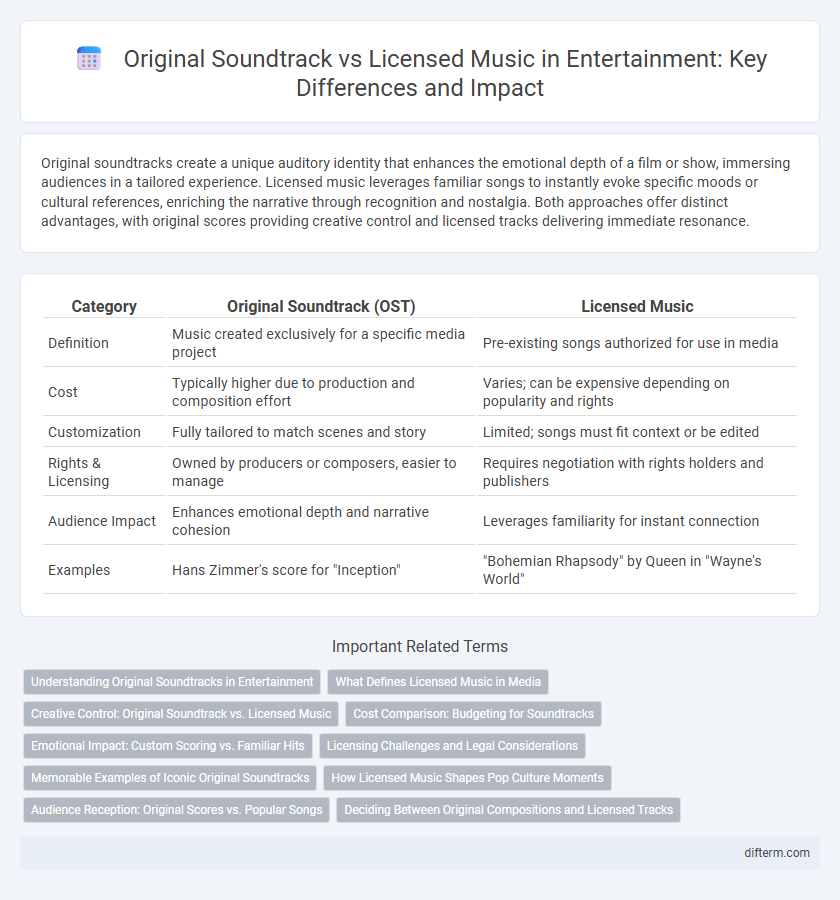Original soundtracks create a unique auditory identity that enhances the emotional depth of a film or show, immersing audiences in a tailored experience. Licensed music leverages familiar songs to instantly evoke specific moods or cultural references, enriching the narrative through recognition and nostalgia. Both approaches offer distinct advantages, with original scores providing creative control and licensed tracks delivering immediate resonance.
Table of Comparison
| Category | Original Soundtrack (OST) | Licensed Music |
|---|---|---|
| Definition | Music created exclusively for a specific media project | Pre-existing songs authorized for use in media |
| Cost | Typically higher due to production and composition effort | Varies; can be expensive depending on popularity and rights |
| Customization | Fully tailored to match scenes and story | Limited; songs must fit context or be edited |
| Rights & Licensing | Owned by producers or composers, easier to manage | Requires negotiation with rights holders and publishers |
| Audience Impact | Enhances emotional depth and narrative cohesion | Leverages familiarity for instant connection |
| Examples | Hans Zimmer's score for "Inception" | "Bohemian Rhapsody" by Queen in "Wayne's World" |
Understanding Original Soundtracks in Entertainment
Original soundtracks (OSTs) are composed specifically for entertainment projects, enhancing narrative depth and emotional engagement through tailored melodies and sound design. Unlike licensed music, which involves pre-existing tracks integrated into a production, OSTs provide unique audio identities that align closely with visual elements and storytelling. This bespoke composition process often elevates audience immersion and can become iconic, influencing the cultural impact of films, television series, and video games.
What Defines Licensed Music in Media
Licensed music in media refers to songs or compositions that are legally authorized for use through agreements with rights holders, enabling content creators to incorporate popular or pre-existing tracks. These licenses often include synchronization rights, master use rights, and performance rights, ensuring proper compensation to artists, composers, and record labels. Unlike original soundtracks, licensed music leverages pre-established emotional connections and cultural significance, enhancing the audience's engagement and the narrative's impact.
Creative Control: Original Soundtrack vs. Licensed Music
Original soundtracks offer filmmakers complete creative control, enabling composers to tailor music specifically to the mood and narrative of the production. Licensed music limits this flexibility, as existing tracks must fit scenes without altering the original composition. This control difference significantly impacts the emotional resonance and cohesion of entertainment projects.
Cost Comparison: Budgeting for Soundtracks
Original soundtracks often require significant investment in composers, recording, and production, but they provide exclusive control over music rights and potential royalties. Licensed music can be more cost-effective upfront, yet licensing fees and restrictions vary widely depending on song popularity and usage length, impacting the overall budget unpredictably. Budgeting for soundtracks demands a careful balance between originality, rights management, and long-term financial implications within entertainment projects.
Emotional Impact: Custom Scoring vs. Familiar Hits
Original soundtracks provide a tailored emotional experience by synchronizing music cues precisely with narrative moments, enhancing viewers' immersion and emotional resonance. Licensed music offers instant familiarity and nostalgia, triggering pre-existing emotional connections and broadening audience appeal through well-known hits. Balancing custom scoring with carefully selected licensed tracks can amplify a production's emotional depth while leveraging audience recognition.
Licensing Challenges and Legal Considerations
Licensing challenges in entertainment arise from complex negotiation processes and high costs involved in securing rights for licensed music, often leading producers to opt for original soundtracks to maintain full control and avoid legal disputes. Original soundtracks minimize risks related to copyright infringement and royalty payments, streamlining distribution and monetization across platforms. Legal considerations require thorough clearance and perpetual rights management for licensed music, emphasizing the importance of comprehensive contracts to protect creative content in film, television, and video game industries.
Memorable Examples of Iconic Original Soundtracks
Iconic original soundtracks like John Williams' score for *Star Wars* and Hans Zimmer's composition for *Inception* exemplify how original music can define a film's identity and enhance emotional impact. These soundtracks create unique auditory experiences tailored to the narrative, unlike licensed music that often brings existing cultural context. Memorable scores become inseparable from their films, proving that original soundtracks contribute significantly to the cinematic legacy and fan engagement.
How Licensed Music Shapes Pop Culture Moments
Licensed music plays a pivotal role in shaping pop culture by instantly connecting audiences to specific emotions and eras through familiar sounds in films, TV shows, and commercials. The strategic use of popular tracks in key scenes enhances storytelling and drives trends, often reviving classic hits into mainstream consciousness. This synergy between licensed music and visual media creates iconic cultural moments that resonate across generations, influencing fashion, social behavior, and entertainment consumption.
Audience Reception: Original Scores vs. Popular Songs
Audience reception to original scores often emphasizes emotional connection and narrative immersion, with compositions crafted to enhance specific scenes and character arcs. Licensed music, featuring popular songs, tends to evoke nostalgia and cultural resonance, boosting relatability and immediate recognition. Both approaches shape viewer engagement uniquely, influencing overall entertainment experience and emotional impact.
Deciding Between Original Compositions and Licensed Tracks
Choosing between original compositions and licensed tracks hinges on factors like creative control, budget, and audience impact. Original soundtracks offer unique, tailor-made music enhancing storytelling and brand identity, while licensed music provides familiar tunes that can evoke instant emotional connections and potentially broaden appeal. Careful assessment of production needs and target demographics guides the selection for maximum entertainment value.
original soundtrack vs licensed music Infographic

 difterm.com
difterm.com